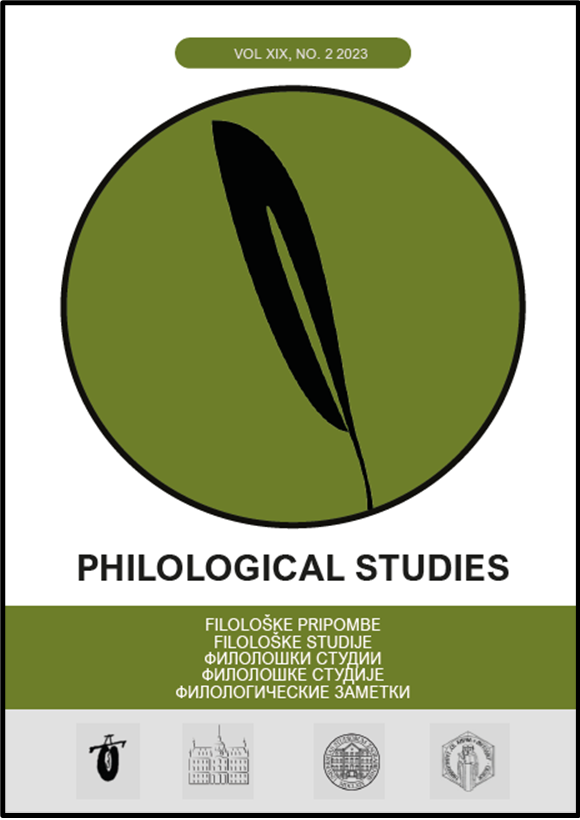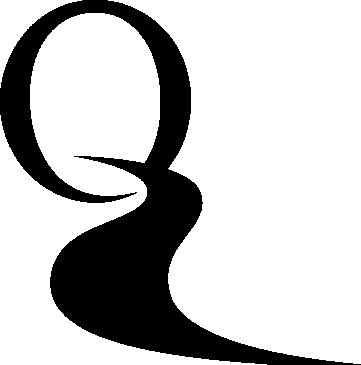СЕМАНТИЧКО-СТРУКТУРНИ ПАРАЛЕЛИ НА ФРАЗЕМИТЕ СО КОМПОНЕНТА ’ОКО’ ВО МАКЕДОНСКИОТ И ВО ЧЕШКИОТ ЈАЗИК
Апстракт
Each language has a wide number of phrases which comprise a very important part of the lexical stock of the language. In the Czech and Macedonian phraseology there is a range of interlingual parallels, common features in the content and form, which are explained both on genetic and typological basis. The phrases which are going to be presented in this paper are the somatic phrases which consist the word ’eye’ as a component. For these phrases it can be said that are the ones of the most frequent in everyday communication. The paper focuses on part of the phrases having the component ’eye’ both in Macedonian and Czech language. As a result of their juxtaposition in regard to the manner of expressing the same meaning in both languages, the phrases can be divided in three groups: 1. The component ’eye’ is present both in Macedonian and Czech language and the respective meaning is expressed in the same manner, with same language terms. 2. The component ’eye’ is present in both languages, but the meaning is not expressed with the same terms. 3. The third group can be divided in two sub-groups as follows: a) the component ’eye’ is not present in one of the languages, but some element of the phrase is related with the function of the eye to see; b) the component ’eye’ is not present in one of the languages and the respective meaning in the other language is expressed in completely different way. Based on the analyzed examples, it can be concluded that both language are very rich in phrases inspired by the eye as part of the human body. The analysis shows the closeness in the associative- pictorial thought of the speakers of both languages – Macedonia and Czech. Therefore, the study of this layer of phraseology, especially in regard to the juxtaposition of Slavic languages is of exceptional interest.
Downloads
Референци
Kol.autorů. 1983. Slovník české frazeologie a idiomatiky. Praha: ACADEMIA.
Přirovnání.
Kol.autorů. 1988. Slovník české frazeologie a idiomatiky. Praha: ACADEMIA.
Výrazy neslovesné.
Kol.autorů. 1989. Slovník spisovného jazyka českého. Praha: ACADEMIA. III, MO.
Kol.autorů. 1994. Slovník české frazeologie a idiomatiky. Praha: ACADEMIA.
Výrazy slovesné A-P.
Levý, J. 1998. Umění překladů. Praha: Ivo Železný.
Mrhačová, Е. 2000. Názvy částí těla v české frazeologii a idiomatice. Ostrava: Spisy
Filozofické fakulty ostravské univerzity.
Велјановска, Катерина. 1998. Фразеолошките изрази во македонскиот јазик
(со посебен осврт на соматската фразеологија): докторска дисертација.
Скопје: Филолошки факултет „Блаже Конески“.
Кол.автори. Ред. Конески, Бл. 1994. Речник на македонскиот јазик (со
српекохрватски толкувања). Скопје: Детска радост. Т. 2.
Попспирова, Таисия. 1977: Некоторые структурно – грамматические
параллели македонской и русской соматической фразеологии. Во: Годишен
зборник на Филолошкиот факултет. Скопје. С. 123–126.
Попспирова, Таисия. 1980. О структуре и семантике ФЕ с соматическим
компонентом ’голова’ в македонском и русском языках. Во: Годишен
зборник на Филолошкиот факултет. Скопје. С. 175–180.
Роус, Д.; Јанчулева, Р. 2006. Фразеолошките еквиваленти во македонскиот и
рускиот превод на романот Доживувањата на добриот војник Швејк. Во:
Славистички студии. Бр. 12. Скопје: Филолошки факултет „Блаже
Конески“.
Тресидер, Џек. 2001. Речник на симболи. Скопје: Три.
Шевалие, Ж.; Гербран, А. 2005. Речник на симболите. Скопје: Табернакул.
Авторите во списанието претставуваат оригинални дела врз основа на резултатите од сопственото истражување. Лицата кои дале значителен придонес во трудот се наведуваат како коавтори. Заедно со статијата, авторите (и коавторите, доколку ги има) треба да достават пополнет образец за пријава на трудот (Paper Submission Form), со кој се потврдува согласноста на авторот за објавување на трудот.
Списанието прифаќа научни трудови кои претходно не биле објавени. Не се прифаќаат трудови кои во голема мера ги повторуваат претходно објавените трудови на авторите. Повторувањето подразбира и компилација – текст составен од фрагменти од објавена монографија или голем број на претходно објавени статии. Плагијатот не е дозволен, како и прекумерното цитирање на туѓи трудови (една третина или повеќе од целиот труд). Сите цитати, цитирани извадоци и материјали мора да имаат цитирани автори и извори. Ако уделот на туѓиот труд е преголем, се препорачува да се скратат цитатите и да се зголеми обемот на оригиналниот текст.
Авторот треба да ги има сите потребни дозволи за користење на позајмените материјали и материјалите на други автори што ги користи во својот труд (илустрации и слично). Авторот гарантира дека статијата не содржи информации што не подлежат на објавување во отворен печат, вклучувајќи ги и оние што содржат или претставуваат доверливи информации.
Во списокот на литературата се вклучени само делата цитирани во трудот, како и линковите за страниците и изворите од кои е цитирано доколку станува збор за извори од интернет. На авторот му се препорачува да ги наведе во текстот изворите на финансиска поддршка на спроведените истражувања и стипендиите, доколку ги имало. Исто така, може да се изрази благодарност и до колегите кои придонеле или помогнале околу работата на текстот, а кои не се коавтори.
Со доставувањето на ракописот и образецот на апликација до редакцијата, авторот официјално се согласува со објавувањето на неговиот труд во „Филолошки студии“. Авторите се носители на авторски права и ги задржуваат сите права за објавување и користење на статијата. Авторите имаат право да ја повлечат статијата во кое било време до моментот на објавување на сајтот, со тоа што претходно за тоа, по писмен пат, треба да ја известат редакцијата на списанието.
Статиите се објавуваат бесплатно. Содржината е достапна под лиценцијата Creative Commons Attribution-Noncommercial-No Derivative Works 3.0 Unported License.
Издавачка Етика
Редакција
Сите трудови доставени до Редакцијата ги читаат прво нејзините членови и соработници за да се утврди дали се однесуваат тие на релевантната проблематика и дали одговараат на форматот на списанието. Редакцијата на „Филолошки студии“ гарантира дека разгледувањето на доставените трудови и нивните рецензии не зависат од: комерцијални интереси, пол, националност, верски убедувања, политички ставови и други фактори. Единствениот критериум при изборот е академското ниво на трудот.
Во зависност од рецензијата, статијата може веднаш да се прати за објавување, да биде отфрлена или испратена до авторот за измена и за доработка. Во случај на несогласување со забелешките на рецензентот, авторот има право да ги оправда своите ставови. Доколку од рецензентите се добиени контрадикторни мислења, текстот се упатува на трет рецензент или конечната одлука се заснова на гласање на членовите на Редакцијата, по одделното разгледување.
Рецензенти
Статиите испратени до Редакцијата минуваат процес на двојно анонимно рецензирање. Имињата на рецензентите не треба да му бидат познати на авторот на статијата и обратно. Рокот за рецензирање е три-четири седмици. Рецензентите можат да бидат членови на Редакцијата и автори на списанието што објавувале претходно во него. Онаму каде што е неопходно, за рецензенти се назначуваат специјалисти од други: организации, градови и земји.
Рецензентите треба да бидат специјалисти за предметно-тематската област на која се однесува статијата. Редакцијата треба да спречи каков било судир на интереси во врска со дадениот научен труд и со неговиот автор.
Рецензентот е должен да им обрне внимание на членовите на Редакцијата за секоја суштинска сличност или поистоветување меѓу ракописот што се рецензира и која било друга публикација што му е позната. Рецензентот, исто така, е должен да го држи во тајност трудот што му е доверен, да не го пренесува на трети лица ракописот што му е доверен нему за рецензија и пред објавувањето на публикацијата да не ги објавува информациите содржани во него.
Рецензентите треба да дадат објективна, непристрасна и аргументирана процена на трудот. Забелешките треба да бидат формулирани коректно, така што оценувањето на трудот се однесува само на текстот на статијата и на неговата содржина. Рецензијата треба да биде напишана добронамерно, а наведените забелешки имаат за цел да им помогнат на авторите да ги коригираат утврдените недостатоци и да ја подобрат статијата пред да биде објавена таа на веб-страницата на издавачот и пред да биде достапна за пошироката публика.










